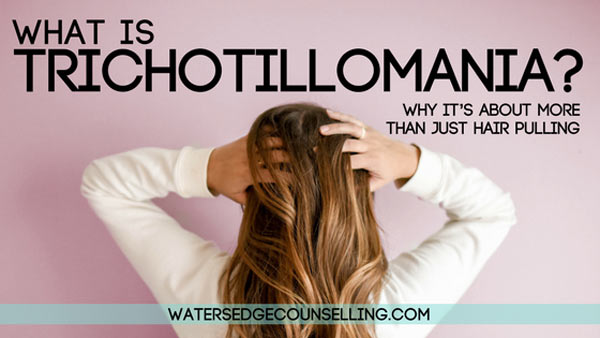
Watersedge has covered a vast spectrum of mental health disorders on our blog, but we have never discussed trichotillomania, the compulsive pulling of one’s hair. Licensed mental health counsellor and writer for Trichstop GinaMarie G. sheds some light on this epidemic for us where she looks at trichotillomania by numbers.
Trichotillomania is a mental health disorder in which a person suffers from the irresistible urge to pull out his or her own hair.
It is a disorder that stems from difficulties regulating anxiety and impulse control. People with trichotillomania often struggle to feel as though they fit in with others, and feel self-conscious about the way people see them and their illness.
People with trichotillomania suffer from several symptoms that can be confusing and off-putting for a person who does not understand what it is like to suffer from trichotillomania. The symptoms of trichotillomania are more visually apparent than other mental health disorders, since the behaviour and consequences are difficult to hide.
Such symptoms and behaviours include:
-
Chewing on hair
-
Eating hair
-
Pulling hair out
-
Compulsively twirling hair
-
Missing clumps of hair from face, head, eyelashes or eyebrows
-
Having bald patches and sores on scalp and face
Each of these symptoms is difficult to hide or conceal, and can be considered unsightly and nonsensical to a person who suffers from trichotillomania. This causes a person who suffers from trichotillomania to feel isolated and alone. It is lonely to feel so misunderstood and singled out, especially since the disorder seems so unusual. In fact, most people do not realise how prevalent trichotillomania actually is in the population.
How Many People Suffer From Trichotillomania?
At this point in time, it is estimated that on average, .5 to 3 per cent of the population will suffer from trichotillomania at some point during their lifetime. This means they will experience trichotillomania symptoms that will have a significant impact on their quality of life for significant periods of time. Some cases will be chronic, meaning they are strong and withstanding, with a steady display of symptoms over time. Other cases will be situational. This means that the symptoms will surface and fade, depending on different elements, like:
- Prevalence of triggers
- Level of stress in day-to-day life
- Ability to cope with triggers and stress
- Engagement in therapy and treatment services
It is important to consider that this statistic is based on the data collected from people who have acknowledged having trichotillomania. This implies that the statistic of .5 to 3 per cent of the population does not account for people who have trichotillomania and do not feel comfortable with talking about, seeking help for, or disclosing that they also suffer from the disorder.
Considering that many people who struggle with trichotillomania feel a sense of shame and embarrassment about having the disorder and prefer to not discuss the details of their case, it is safe to assume that the actual percentage of people who suffer from trichotillomania is likely higher than this evidenced based statistic.
What Are The Demographics Of Trichotillomania?
To date, an estimated 2.5 million people in the United States suffer from trichotillomania at some point in their lifetime, and it currently impacts up to 920,000 Australians. On average, a person will begin to show signs of trichotillomania between the ages of 9 and 13 years old, but people can begin to show signs as early as 4 and at any point during adolescence or adulthood.
Gender And Race Statistics
Statistics show that significantly more females will suffer from trichotillomania than men. According to the American Journal of Psychiatry (2016), for every one man who reports suffering from trichotillomania, there are four women also suffering from the disorder. This means that there are four times as many women who report having suffered from trichotillomania as men.
Presently, there is no data that shows a significant difference in the prevalence of trichotillomania between racial groups.
Comorbidity Statistics
“Comorbidity” is a term used to refer to a person who suffers from more than one type of mental health disorder. Trichotillomania is often not the only mental health disorder a person suffers from when he or she suffers from the disorder. According to the American Association of Psychiatry, an estimated 60 per cent of trichotillomania cases are comorbid with another mental health disorder. Most people of trichotillomania also suffer from an anxiety disorder, depression, obsessive-compulsive disorder, or another type of impulse control disorder. Furthermore, an estimated 5 per cent of people who suffer from trichotillomania also suffer from posttraumatic stress disorder.
Trichotillomania is more prevalent in the population than people tend to realise. There are several reasons for this; between the shame and guilt felt by people who suffer from the disorder and lack of information and awareness about the disorder, it is easy to understand why most people do not fully understand what trichotillomania is or how many people it affects.
Trichotillomania is a disorder that affects many people and does have a significant impact on an affected person’s quality of life. Fortunately, with proper treatment and therapeutic intervention, it is possible to recover from the disorder and learn coping skills needed to maintain control and minimise its damaging symptoms.
GinaMarie G. is a licensed mental health counsellor, writing about mental health in general and about OCD and related disorders in particular, for trichstop.com.
Do you struggle with trichotillomania? Are you concerned a loved one may partake in chronic hair pulling? Contact Colleen on 0434 337 245 or Duncan on 0434 331 243 for a FREE 10-minute phone consultation on how we can best help you, or press book now.
Leave a Reply